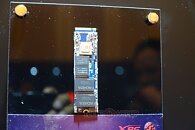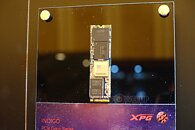InnoGrit Starts Mass Producing YRS820 PCIe 5.0 Controller, Based on RISC-V Architecture
InnoGrit's low-wattage 12 nanometer IG5666 controller popped up on the T-FORCE GE PRO PCIe 5.0 SSD series earlier in the year, but attention has turned to another consumer-grade design. Parent company—Yingren Technology—is not well known outside of China, although its InnoGrit brand has started to make inroads within Western markets. The enterprise-level YRS900 PCIe 5.0 SSD controller was announced last September—this open-source RISC-V-based solution was designed/engineered to "align with U.S. export restrictions." According to cnBeta and MyDrivers reports, a new YRS820 controller has successfully reached the mass production phase. This is a PCIe 5.0 consumer-grade controller, likely derived from its big sibling (YRS900).
According to InnoGrit presentation material, their new model is based on: "RISC-V instruction architecture, adopts a 4-channel PCIe 5.0 interface, is equipped with 8 NAND flash memory channels, supports NVMe 2.0 protocol, has an interface transmission rate of 2667MT/s, can be paired with 3D TLC/QLC, and supports a maximum capacity of up to 8 TB." Company representatives stated that the YRS820 controller is destined to be fitted on high-end consumer parts—the AI PC market segment is a key goal, since the YRS820 is able to: "accelerate data processing for specific applications and have high stability, consistency and security." cnBeta highlighted some anticipated performance figures: "YRS820 achieves sequential read 14 GB/s, sequential write 12 GB/s, random read and random write up to 2000K IOPs and 1500K IOPs respectively." InnoGrit did not reveal a release timetable, since their latest consumer-grade controller is going through a validation process. The company is currently collaborating with domestic NAND flash memory and DRAM manufacturers, as well as other industry bodies.
According to InnoGrit presentation material, their new model is based on: "RISC-V instruction architecture, adopts a 4-channel PCIe 5.0 interface, is equipped with 8 NAND flash memory channels, supports NVMe 2.0 protocol, has an interface transmission rate of 2667MT/s, can be paired with 3D TLC/QLC, and supports a maximum capacity of up to 8 TB." Company representatives stated that the YRS820 controller is destined to be fitted on high-end consumer parts—the AI PC market segment is a key goal, since the YRS820 is able to: "accelerate data processing for specific applications and have high stability, consistency and security." cnBeta highlighted some anticipated performance figures: "YRS820 achieves sequential read 14 GB/s, sequential write 12 GB/s, random read and random write up to 2000K IOPs and 1500K IOPs respectively." InnoGrit did not reveal a release timetable, since their latest consumer-grade controller is going through a validation process. The company is currently collaborating with domestic NAND flash memory and DRAM manufacturers, as well as other industry bodies.












































